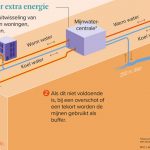.
Most residences have a centralized heating with a central-heating boiler, piping and radiators. This causes unnecessary high energy usage and its resulting emissions. A decentralized unit can largely decrease this wastage and air pollution, says Bart Vlaar of Tegnis.

Tegnis is a startup, partly owned by VolkerWessels, that is involved with dat sinds het begin bij Stroomversnelling is betrokkensince the beginning. The other half of Tegnis is in the hands of its three founders, among which Bart Vlaar. The three gentlemen each have a different background: one from aerospace engineering, one from the building sector, while Vlaar has his roots in product development. “We have known each other for a while through our business network. Because of Stroomversnelling we ended up at VolkerWessels,” says Vlaar. He doesn’t feel like his experience in construction is a burden, but more of an advantage when it comes to innovation.
Zero-energy
From his car, Vlaar explains how Tegnis is founded. “With VolkerWessels we thought about which concepts could be applied for zero-energy homes. Our goal was to come up with concepts that are as efficient as possible and are ready-to-go coming from the factory. For that, we executed several pilots with VolkerWessels. From that cooperation, Tegnis was founded. We still develop products for VolkerWessels, regarding automation and coming up with new solutions.”

Decentralized unit
One of those new products developed by Tegnis, is the decentrale unit (DCU). A smart and integrated device that controls heating, cooling and air ventilation per single space. It is meant for new to build residences, but can also replace existing heating and ventilation systems. The decentralized operation controls a space’s indoor climate. “Because of that no extensive transport of heat and air is needed through the whole house, resulting that no spaces are unnecessarily heated of ventilated. It prevents energy dissipation.”
Big difference with central-heating
According to Vlaar, this is a major difference with pipes that results in a higher energy usage. Next to energy wastage also air pollution is a result of a centralized ventilation system. “The decentralized unit is obtainable with an integrated ionizer that charges ultra and nano particulate matter and then efficiently lets it cake together with other dust particles or deposits it on the floor or wall. This has a reason: particles under the 5 micron in size enter the bloodstream directly through the lungs and can cause numerous medical complaints. Bigger particles are caught by mucous membranes in the respiratory tract, to then be transported in a natural way.”
Integrated components
The decentralized unit is installed against the outer facade at radiator level. “In the outer unit, the one that can be hidden in the facade, components like the compressor, ventilators and vaporizer unit are located. The inner unit contains the heat exchange unit, condenser and circulation ventilators. The device has sensors to measure humidity, CO2 levels and temperature of the climate inside. The decentralized unit comes in three versions: the first one has a micro heat pump and an electric auxiliary element, the second just an electric heating element, and the third has a water side connection for low temperature heating so that it can be connected to a heating network at both low and high temperatures.
All electric
During the development of this device, a lot is learned from experiences from the market, says Vlaar. “Newly built homes are so well insulated that rooms like the bedroom hardly ask for any heating. Those spaces don’t require a heat pump for heating, but mainly for cooling. Therefor, we developed an all electric system that still contains all the other functionalities. It has become the second version.” Vlaar adds that all versions can be applied in both high and low buildings. “The water side version is meant for residences that have a centralized heat source.”
Monitoring
Residents can control the temperature themselves, but it can be limited. A centralized control system has been developed so every resident can read out all units on a single screen. The units can be equipped with integrated monitoring per series from the factory. “The development of the decentralized unit is ready,” says Vlaar as an answer to what the current status is. “Kiwa and other quality labels are granted. The device is tested extensively in the field. After some final changes the current design arose.”
De role of WeLLDesign
From 2010 to 2013, WeLLDesign has worked intensively with VolkerWessels in the development of the MorgenWonen concept. Also along with its subsidiary company Tegnis, WeLLDesign works together to develop the DCU into an industrial product for large series production.
What now?
The current challenge is to market the decentralized unit with the public and gaining the confidence of the market. Therefore, Vlaar is enthusiastic about showing the device to the market soon.
Bart Vlaar shows the DCU at the innovation market during Energy-Up on October 2nd. here .




